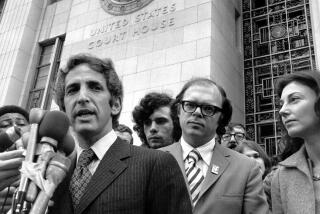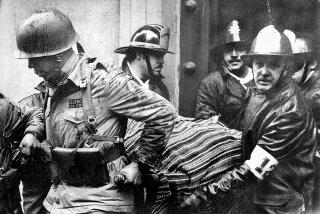Papers Revive Enduring Fascination of â40s Hiss Spy Case
WASHINGTON â The case of Alger Hiss, accused of being a communist spy in the State Department, had plenty of intrigue to rivet the nation in the late 1940s: Soviet espionage, the communist underground in America. Secret papers hidden in a hollowed-out pumpkin.
It still arouses interest today. The governmentâs release of 4,200 pages of grand jury testimony from the Hiss case Tuesday packed a news conference with reporters and historians and reignited debate about the controversial case.
Hissâ son, Tony, said the transcripts will support his fatherâs innocence: âClearly there is a great deal of material here that, had it been known, would have been a great help to the defense,â he said. But some Cold War historians argued that the testimony will support Richard Nixonâs belief that Hiss was a traitor.
Nixon, then a young congressman from California and a member of the communist-hunting House Committee on Un-American Activities, was determined to expose Hiss.
His zealous pursuit was a springboard to the Senate. Yet his unusual, eleventh-hour appearance as a grand jury witness was criticized as political interference in the legal process and raised questions about the fairness of Hissâ indictment.
Hiss was imprisoned for four years on two counts of perjury. Nixon went on to become a senator, vice president and president.
The case against Hiss began when Whittaker Chambers, an underground courier for the Communist Party who later turned his back on communism and became a senior editor for Time magazine, accused Hiss of being a communist mole.
The accusation startled many Americans. It was one thing for the communist threat to exist far away, behind the Iron Curtain, but quite another for communists to work in high-level corridors of the governmentâs diplomatic agency.
David Vladeck, director of the Public Citizen Litigation Group, which petitioned for release of the records, agreed that some of the newly released testimony might have aided Hissâ defense.
âChambers changed his story before the grand jury on multiple occasions. Some of the occasions are really shocking,â Vladeck said, citing Chambersâ misidentification of a photographer who had taken pictures of secret documents.
Vladeck also questioned whether it was proper for Nixon to be a grand jury witness.
Nixon testified on Dec. 13, 1948. He arrived carrying metal canisters containing microfilm of the âpumpkin papersâ--hundreds of pages of documents representing material that Hiss was said to have given Chambers. Just days before Nixon took the stand, Chambers had pulled the film from a hollowed-out pumpkin at his farm in Westminster, Md.
âThis is extraordinary--in the middle of a criminal investigation--a member of Congress is withholding evidence [the microfilm] from the Justice Department,â Vladeck said.
On the other hand, Sam Tanenhaus, author of a biography of Chambers, said he thinks the grand jury transcripts will provide historians further evidence of Hissâ guilt.
âWhat you see is the rawness of Alger Hissâ testimony at the moment heâs been trapped,â Tanenhaus said.
Bruce Craig, a historian who has read all 4,200 pages of documents, said Nixon lobbied strongly for Hissâ indictment but his oratory did not amount to blatant manipulation of the grand jury process.
More to Read
Get the L.A. Times Politics newsletter
Deeply reported insights into legislation, politics and policy from Sacramento, Washington and beyond. In your inbox three times per week.
You may occasionally receive promotional content from the Los Angeles Times.










